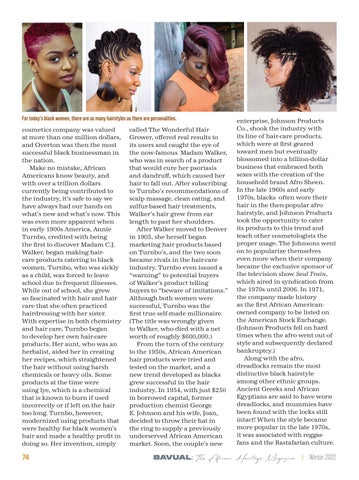For today’s black women, there are as many hairstyles as there are personalities. cosmetics company was valued at more than one million dollars, and Overton was then the most successful black businessman in the nation. Make no mistake, African Americans know beauty, and with over a trillion dollars currently being contributed to the industry, it’s safe to say we have always had our hands on what’s new and what’s now. This was even more apparent when in early 1900s America, Annie Turnbo, credited with being the first to discover Madam C.J. Walker, began making haircare products catering to black women. Turnbo, who was sickly as a child, was forced to leave school due to frequent illnesses. While out of school, she grew so fascinated with hair and hair care that she often practiced hairdressing with her sister. With expertise in both chemistry and hair care, Turnbo began to develop her own hair-care products. Her aunt, who was an herbalist, aided her in creating her recipes, which straightened the hair without using harsh chemicals or heavy oils. Some products at the time were using lye, which is a chemical that is known to burn if used incorrectly or if left on the hair too long. Turnbo, however, modernized using products that were healthy for black women’s hair and made a healthy profit in doing so. Her invention, simply
74
called The Wonderful Hair Grower, offered real results to its users and caught the eye of the now-famous Madam Walker, who was in search of a product that would cure her psoriasis and dandruff, which caused her hair to fall out. After subscribing to Turnbo’s recommendations of scalp massage, clean eating, and sulfur-based hair treatments, Walker’s hair grew from ear length to past her shoulders. After Walker moved to Denver in 1905, she herself began marketing hair products based on Turnbo’s, and the two soon became rivals in the hair-care industry. Turnbo even issued a “warning” to potential buyers of Walker’s product telling buyers to “beware of imitations.” Although both women were successful, Turnbo was the first true self-made millionaire. (The title was wrongly given to Walker, who died with a net worth of roughly $600,000.) From the turn of the century to the 1950s, African American hair products were tried and tested on the market, and a new trend developed as blacks grew successful in the hair industry. In 1954, with just $250 in borrowed capital, former production chemist George E. Johnson and his wife, Joan, decided to throw their hat in the ring to supply a previously underserved African American market. Soon, the couple’s new
BAVUAL:
enterprise, Johnson Products Co., shook the industry with its line of hair-care products, which were at first geared toward men but eventually blossomed into a billion-dollar business that embraced both sexes with the creation of the household brand Afro Sheen. In the late 1960s and early 1970s, blacks often wore their hair in the then-popular afro hairstyle, and Johnson Products took the opportunity to cater its products to this trend and teach other cosmetologists the proper usage. The Johnsons went on to popularize themselves even more when their company became the exclusive sponsor of the television show Soul Train, which aired in syndication from the 1970s until 2006. In 1971, the company made history as the first African Americanowned company to be listed on the American Stock Exchange. (Johnson Products fell on hard times when the afro went out of style and subsequently declared bankruptcy.) Along with the afro, dreadlocks remain the most distinctive black hairstyle among other ethnic groups. Ancient Greeks and African Egyptians are said to have worn dreadlocks, and mummies have been found with the locks still intact! When the style became more popular in the late 1970s, it was associated with reggae fans and the Rastafarian culture.
The African Heritage Magazine
| Winter 2022
